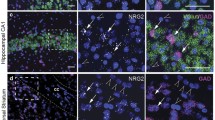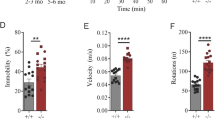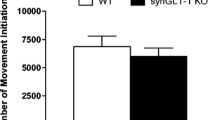Abstract
Rationale
The structurally related neuropeptides, substance P, neurokinin A, and neurokinin B, belong to a family of molecules termed tachykinins and are widely distributed in the central and peripheral nervous systems. These peptides mediate their effects through three G protein coupled receptor subtypes, the neurokinin-1, neurokinin-2 and neurokinin-3 receptors, respectively.
Objective
To study the physiological functions of NK3, a line of NK3 knockout mice were generated and characterized in a broad spectrum of well-established behavioral tests.
Results
In several tests, including spontaneous locomotor activity, elevated plus maze, forced swim, and hot plate, wild-type and knockout mice performed similarly. However, in several cognition tests, including passive avoidance, acquisition of conditioned avoidance responding (CAR), and the Morris water maze, NK3 knockout mice displayed deficits compared to wild-type mice. Although NK3 wild-type and knockout mice performed similarly in the training phase of the passive avoidance test, knockout mice had shorter latencies to enter the dark compartment on days 3 and 4, suggesting impaired retention. In the acquisition phase of the conditioned avoidance responding assay, NK3 knockout mice acquired the CAR task at a slower rate than wild-type mice. Once the CAR test was acquired, both NK3 wild-type and knockout mice responded similarly to clozapine and risperidone, drugs which suppress responding in this test. In the Morris water maze, NK3 knockout mice showed increased latencies to find the escape platform on day 3 of training, suggesting a modest, but significant delay in acquisition compared to wild-type mice.
Conclusion
These studies suggest a role for NK3 in learning and memory in mice.







Similar content being viewed by others
References
Almeida TA, Rojo J, Nieto PM, Pinto FM, Hernandez M, Martin JD, Candenas ML (2004) Tachykinins and tachykinin receptors: structure and activity relationships. Curr Med Chem 11:2045–2081
Arenas E, Alberch J, Perez-Navarro E, Solsona C, Marsal J (1991) Neurokinin receptors differentially mediate endogenous acetylcholine release evoked by tachykinins in the neostriatum. J Neurosci 11:2332–2338
Ashford J, Jones BJ (1976) The effects of intra-amygdaloid injections of 6-hydroxy-dopamine on avoidance responding in rats. Br J Pharmacol 56:255–261
Bannon MJ, Brownschidle LA, Tian Y, Whitty CJ, Poosch MS, D’sa C, Moody CA (1995) Neurokinin-3 receptors modulate dopamine cell function and alter the effects of 6-hydroxydopamine. Brain Res 695:19–24
Boix F, Mattioli R, Adams F, Huston JP, Schwarting RK (1992) Effects of substance P on extracellular dopamine in neostriatum and nucleus accumbens. Eur J Pharmacol 216:103–107
Boix F, Pfister M, Huston JP, Schwarting RK (1994) Substance P decreases extracellular concentrations of acetylcholine in neostriatum and nucleus accumbens in vivo: possible relevance for the central processing of reward and aversion. Behav Brain Res 63:213–219
Buell G, Schulz MF, Arkinstall SJ, Maury K, Missotten M, Adami N, Talabot F, Kawashima E (1992) Molecular characterisation, expression and localisation of human neurokinin-3 receptor. FEBS Lett 299:90–95
Chen LW, Yung KK, Chan YS (2004) Neurokinin peptides and neurokinin receptors as potential therapeutic intervention targets of basal ganglia in the prevention and treatment of Parkinson’s disease. Current Drug Targets 2:197–206
Crocker AD, Russell RW (1984) The up-and-down method for the determination of nociceptive thresholds in rats. Pharmacol Biochem Behav 21:133–136
Dam T-V, Quirion R (1994) Comparative distribution of receptors types in the mammalian brain. In: Buck SH (ed) The tachykinin receptors. Humana Press, Totowa, NJ, pp 101–123
Dam T-V, Escher E, Quirion R (1990) Visualization of neurokinin-3 receptor in rat brain using the highly selective ligand [3H]senktide. Brain Res 506:175–179
De Souza Silva MA, Hasenohrl RU, Tomaz C, Schwarting RK, Huston JP (2000) Differential modulation of frontal cortex acetylcholine by injection of substance P into the nucleus basalis magnocellularis region in the freely-moving vs. the anesthetized preparation. Synapse 38:243–253
De Souza Silva MA, Mello EL, Müller CP, Jocham G, Maior RS, Huston JP, Tomaz C, Barros M (2006a) Interaction of the tachykinin NK3 receptor agonist senktide with behavioral effects of cocaine in marmosets (Callithrix penicillata). Peptides 27:2214–2223
De Souza Silva MA, Mello EL, Müller CP, Jocham G, Maior RS, Huston JP, Tomaz C, Barros M (2006b) The tachykinin NK3 receptor antagonist SR142801 blocks the behavioral effects of cocaine in marmoset monkeys. Eur J Pharmacol 536:269–278
Ding YQ, Shigemoto R, Takada M, Ohishi H, Nakanishi S, Mizuno N (1996) Localization of the neuromedin K receptor (NK3) in the central nervous system of the rat. J Comp Neurol 364:290–310
Fantin G, Bottecchia D (1984) Effect of nucleus accumbens destruction in rat. Experientia 40:573–575
Fibiger HC, Phillips AG, Zis AP (1974) Deficits in instrumental responding after 6-hydroxydopamine lesions of the nigro-striatal dopaminergic projection. Pharmacol Biochem Behav 2:87–96
Flood JF, Baker ML, Hernandez EN, Morley JE (1990) Modulation of memory retention by neuropeptide K. Brain Res 520:284–290
Hasenohrl RU, Huston JP, Schuurman T (1990) Neuropeptide substance P improves water maze performance in aged rats. Psychopharmacology (Berl) 101:23–26
Hasenohrl RU, Frisch C, Nikolaus S, Huston JP (1994) Chronic administration of neurokinin SP improves maze performance in aged Rattus norvegicus. Behav Neural Biol 62:110–120
Hasenohrl RU, Souza-Silva MA, Nikolaus S, Tomaz C, Brandao ML, Schwarting RK, Huston JP (2000) Substance P and its role in neural mechanisms governing learning, anxiety and functional recovery. Neuropeptides 34:272–280
Hefco V, Yamada K, Hefco A, Hritcu L, Tiron A, Nabeshima T (2003) Role of the mesetelencephaic dopamine system in learning and memory processes in the rat. Eur J Pharmacol 475:55–60
Huston JP, Hasenohrl RU (1995) The role of neuropeptides in learning: focus on the neurokinin substance P. Behav Brain Res 66:117–127
Huston JP, Hasenöhrl RU, Boix F, Gerhardt P, Schwarting RKW (1993) Sequence-specific effects of neurokinin substance-P on memory, reinforcement, and brain dopamine activity. Psychopharmacology 112:147–162
Irwin S (1968) Comprehensive observational assessment: la. A systematic, quantitative procedure for assessing the behavioral and physiologic state of the mouse. Psychopharmacol 13:222–257
Jocham G, Lezoch K, Müller CP, Kart-Teke E, Huston JP, De Souza Silva MA (2006) Neurokinin-3 receptor antagonism attenuates cocaine’s behavioural activating effects yet potentiates its dopamine-enhancing action in the nucleus accumbens core. Eur J Neurosci 24:1721–1732
Kapur S (2003) Psychosis as a state of aberrant salience: a framework linking biology, phenomenology, and pharmacology in schizophrenia. Am J Psychiatry 160(1):13–23
Keegan KD, Woodruff GN, Pinnock RD (1992) The selective NK3 receptor agonist senktide excites a subpopulation of dopamine-sensitive neurones in the rat substantia nigra pars compacta in vitro. Br J Pharmacol 105:3–5
Koob GF, Simon H, Herman JP, LeMoal M (1984) Neuroleptic-like disruption of the conditioned avoidance response requires destruction of both the mesolimbic and nigrostriatal dopamine systems. Brain Res 303:319–329
Krappmann P, Hasenöhrl RU, Frisch C, Huston JP (1994) Self-administration of neurokinin substance P into the ventromedial caudate-putamen in rats. Neuroscience 62:1093–1101
Langlois X, Wintmolders C, te Riele P, Leysen JE, Jurzak M (2001) Detailed distribution of Neurokinin 3 receptors in the rat, guinea pig and gerbil brain: a comparative autoradiographic study. Neuropharmacology 40:242–253
MacQueen GM, Ramakrishnan K, Croll SD, Siuciak JA, Yu G, Young LT, Fahnestock M (2001) Performance of heterozygous brain-derived neurotrophic factor knockout mice on behavioral analogues of anxiety, nociception, and depression. Behav Neurosci 115:1145–1153
Maggi CA (1995) The mammalian tachykinin receptors. Gen Pharmacol 26:911–944
Maggi CA, Schwartz TW (1997) The dual nature of the tachykinin NK1 receptor. Trends Pharmacol Sci 18:351–355
Marco N, Thirion A, Mons G, Bougault I, Le Fur G, Soubrie P, Steinberg R (1998) Activation of dopaminergic and cholinergic neurotransmission by tachykinin NK3 receptor stimulation: an in vivo microdialysis approach in guinea pig. Neuropeptides 32:481–488
Marubio LM, Paylor R (2004) Impaired passive avoidance learning in mice lacking central neuronal nicotinic acetylcholine receptors. Neuroscience 129:575–582
Meltzer H, Prus A (2006) NK3 receptor antagonists for the treatment of schizophrenia. Drug Discov Today 3:555–560
Mileusnic D, Lee JM, Magnuson DJ, Hejna MJ, Krause JE, Lorens JB, Lorens SA (1999a) Neurokinin-3 receptor distribution in rat and human brain: an immunohistochemical study. Neuroscience 89:1269–1290
Mileusnic D, Magnuson DJ, Hejna MJ, Lorens JB, Lorens SA, Lee JM (1999b) Age and species-dependent differences in the neurokinin B system in rat and human brain. Neurobiol Aging 20:19–35
Morris RGM (1984) Developments of a water-maze procedure for studying spatial learning in the rat. J Neurosci Methods 11:47–60
Panocka I, Massi M, Lapo I, Swiderski T, Kowalczyk M, Sadowski B (2001) Antidepressant-type effect of the NK3 tachykinin receptor agonist aminosenktide in mouse lines differing in endogenous opioid system activity. Peptides 22:1037–1042
Pelleymounter MA, Fisher Q, Schlesinger K, Hall M, Dearmey P, Stewart J (1986) The effect of substance P and its fragments on passive avoidance retention and brain monoamine activity. Behav Brain Res 21:119–127
Picciotto, Wickman (1998) Using knockout and transgenic mice to study neurophysiology and behavior. Physiol Rev 78:1131–1163
Porsolt RD, Bertin A, Jalfre M (1977) Behavioral despair in mice: a primary screening test for antidepressants. Arch Int Pharmacodyn Ther 229:327–336
Ribeiro SJ, Teixeira RM, Calixto JB, De Lima TC (1999) Tachykinin NK(3)receptor involvement in anxiety. Neuropeptides 33:181–188
Roder C, Bellmann R, McCarson KE, Krause JE, Sperk G (1994) Kainic acid induced seizures cause a marked increase in the expression of neurokinin-3 receptor mRNA in the rat cerebellum. Neurosci Lett 181:158–160
Saigo A, Takano Y, Matsumoto T, Tran M, Nakayama Y, Saito R, Yamada K, Kamiya H (1993) Central administration of senktide, a tachykinin NK-3 agonist, has an antidiuretic action by stimulating AVP release in water-loaded rats. Neurosci Lett 159:187–190
Schlesinger K, Lipsitz DU, Peck PL, Pelleymounter MA, Stewart JM, Chase TN (1983) Substance P enhancement of passive and active avoidance conditioning in mice. Pharmacol Biochem Behav 19:655–661
Seabrook GR, Bowery BJ, Hill RG (1995) Pharmacology of tachykinin receptors on neurones in the ventral tegmental area of rat brain slices. Eur J Pharmacol 273:113–119
Shughrue PJ, Lane MV, Merchenthaler I (1996) In situ hybridization analysis of the distribution of neurokinin-3 mRNA in the rat central nervous system. J Comp Neurol 372:395–414
Siuciak JA, Fujiwara RA (2004) The activity of pramipexole in the mouse forced swim test is mediated by D2 rather than D3 receptors. Psychopharmacology (Berl) 175:163–169
Siuciak JA, Altar CA, Wiegand SJ, Lindsay RM (1994) Antinociceptive effect of brain-derived neurotrophic factor and neurotrophin-3. Brain Res 633:326–330
Siuciak JA, McCarthy SA, Chapin DS, Fujiwara RA, James LC, Williams RD, Stock JL, McNeish JD, Strick CA, Menniti FS, Schmidt CJ (2006) Genetic deletion of the striatum-enriched phosphodiesterase PDE10A: evidence for altered striatal function. Neuropharmacology 51:374–385
Steinberg R, Rodier D, Souiclhac J, Bougault I, Emonds-Alt X, Soubrie P, Le Fur G (1995) Pharmacological characterization of tachykinin receptors controlling acetylcholine release from rat striatum: an in vivo microdialysis study. J Neurochem 65:2543–2548
Stoessl AJ (1994) Localization of striatal and nigral tachykinin receptors in the rat. Brain Res 646:13–18
Stoessl AJ, Hill DR (1990) Autoradiographic visualization of NK-3 tachykinin binding sites in the rat brain, utilizing [3H]senktide. Brain Res 534:1–7
Stoessl AJ, Dourish CT, Iversen SD (1990) Pharmacological characterization of the behavioural syndrome induced by the NK-3 tachykinin agonist senktide in rodents: evidence for mediation by endogenous 5-HT. Brain Res 517:111–116
Stoessl AJ, Szczutkowski E, Glenn B, Watson I (1991) Behavioural effects of selective tachykinin agonists in midbrain dopamine regions. Brain Res 565:254–262
Stubley-Weatherly L, Harding JW, Wright JW (1996) Effects of discrete kainic acid-induced hippocampal lesions on spatial and contextual learning and memory in rats. Brain Res 716:29–38
Ukai M, Shinkai N, Ohashi K, Kameyama T (1995) Substance P markedly ameliorates scopolamine-induced impairment of spontaneous alternation performance in the mouse. Brain Res 673:335–338
Ukai M, Shinkai N, Kameyama T (1996) Neurokinin A and senktide attenuate scopolamine-induced impairment of spontaneous alternation performance in mice. Nihon Shinkei Seishin Yakurigaku Zasshi 6:97–101
Ukai M, Shinkai N, Kameyama T (1998) Involvement of dopamine receptors in beneficial effects of tachykinins on scopolamine-induced impairment of alternation performance in mice. Eur J Pharmacol 350:39–45
Wadenberg ML, Hicks PB (1999) The conditioned avoidance response test re-evaluated: is it a sensitive test for the detection of potentially atypical antipsychotics? Neurosci Biobehav Rev 23:851–862
Yip J, Chahl LA (2001) Localization of NK1 and NK3 receptors in guinea-pig brain. Regul Pept 98:55–62
Acknowledgements
Portions of this work have been presented at the Society for Neuroscience Meeting, (2006). The authors would like to thank Mary Bauchmann for ES cell work, Dave Raunig for assistance with statistical analyses, and the Genetically Modified Mice breeding group for animal care.
Author information
Authors and Affiliations
Corresponding author
Rights and permissions
About this article
Cite this article
Siuciak, J.A., McCarthy, S.A., Martin, A.N. et al. Disruption of the neurokinin-3 receptor (NK3) in mice leads to cognitive deficits. Psychopharmacology 194, 185–195 (2007). https://doi.org/10.1007/s00213-007-0828-6
Received:
Accepted:
Published:
Issue Date:
DOI: https://doi.org/10.1007/s00213-007-0828-6




